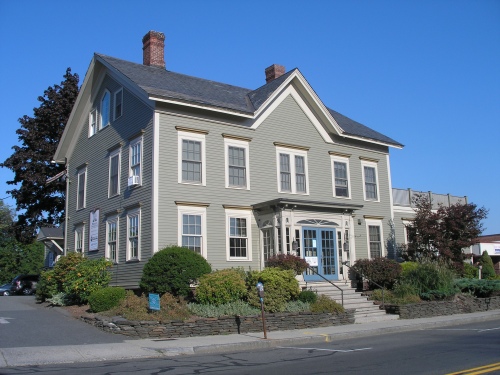W. H. Lyman House (1870)

The Gothic cottage at 319 Elm Street in Northampton, built in 1870, was designed by William Fenno Pratt for W. H. Lyman. A later owner was S. C. Parsons.

The Gothic cottage at 319 Elm Street in Northampton, built in 1870, was designed by William Fenno Pratt for W. H. Lyman. A later owner was S. C. Parsons.

The house at 229 Elm Street in Northampton was built c. 1895 for the Pratt family and may have been designed by William F. Pratt, Jr., son of the architect William Fenno Pratt. The property was sold to Jennie C. Pratt in 1895.

The house at 71 King Street in Northampton was built in 1866 to serve as a parsonage for St. Mary’s Catholic church. It was designed by William Fenno Pratt, who also designed a similar parsonage for the Congregational church. Built in 1845, St. Mary’s was Northampton’s first Catholic church. This almost entirely Irish parish constructed a new church on Elm Street in 1885 and a new French-Canadian parish took over the old church. This was later replaced by a new church, the present Sacred Heart Roman Catholic Church at 101 King Street. Since the move of St. Mary’s Parish, the old parsonage has been used for other purposes, including as a funeral parlor.

In 1860-1861, Northampton manufacturer W.T. Clement built a brick house at what is now 289 Elm Street. In 1879, he sold the house to A.S. Wood, who hired architect William Fenno Pratt to make improvements to building in the form of mansard roofs and a tower.

The house at 82 Bridge Street in Northampton was built in the late eighteenth or early nineteenth century, but the front of the house was remodeled in 1869 by William F. Pratt for then owner George Sargeant. In recent years, the house has been a bed & breakfast called the Hampshire Inn.

Jere Stebbins Lathrop, from West Springfield, became a merchant in Northampton and then in Savannah, Georgia, where he remained until the start of the Civil War. He spent summers in his house at 57 Bridge Street in Northampton, which was built in the 1840s from plans in a book of southern architecture brought north by his wife, Elizabeth. The plans for the house (also known as the Lathrop-Butler House) were executed by architect W.F. Pratt, who would design a similar house using the same plans in 1855 for lawyer Osmyn Baker at 78 Pomeroy Terrace. Not wanting to fight a brother in the Confederate army, Lathrop and his family spent the Civil War in Canada, where he was suspected of supplying goods to Southern blockade runners. The Federal government confiscated his house, which was then bought at public auction by Osmyn Baker, who returned it to Lathrop after the war. J. Stebbins Lathrop continued as a business man in Northampton until his death in 1894.

At 51 Main Street in Northampton is an 1851 sandstone Italianate building designed by William Fenno Pratt. The building is home to Smith Charities, an organization which aids indigent children and women. As explained in the American Journal of Education, Vol. 27, No. 7, (July 1877):
This large and comprehensive system or charities was founded by Oliver Smith, Esq., of Hatfield, who died Dec. 22, 1845. His estate was valued, at the time of his death, at $370,000. In his will, he directed that a board of trustees should be constituted in the following manner: The towns of Northampton, Hadley, Hatfield, Amherst, and Williamsburg, in Hampshire County, and Deerfield, Greenfield, and Whately, in Franklin County, shall choose at each annual meeting a person who shall be called an elector. The electors were to choose three persons who should constitute a board of trustees, who were to have the control and management of all the funds.
Some of Smith’s heirs contested his will, resulting in a trial in July 1847. As the above article relates, “Two days were occupied in the trial, Rufus Choate arguing the case for the heirs-at-law, and Daniel Webster for the will. The courthouse was crowded to overflowing, and ladders were put up to the windows, so eager were the people to see and hear the great orators.” As described in Early Northampton (1914):
The heirs—among them Austin Smith (a nephew of Oliver Smith and a brother of Sophia Smith, founder of Smith College)—wished to break the will, claiming that while the law required three competent witnesses to such a document, only two of the witnesses of the Oliver Smith will were in fit condition to sign it. Oliver Smith, another of the heirs, also a nephew of Oliver Smith, Sr., and executor of the will, determined, against his own interests, to uphold it, and engaged Daniel Webster, with Judge Forbes as junior counsel. Charles Delano was also retained—the latter two being Northampton lawyers. Webster, by his remarkable personality and brilliancy, and by his judicious handling of the witnesses, gained the case, in spite of the utmost efforts of his able antagonist, Mr. Choate.